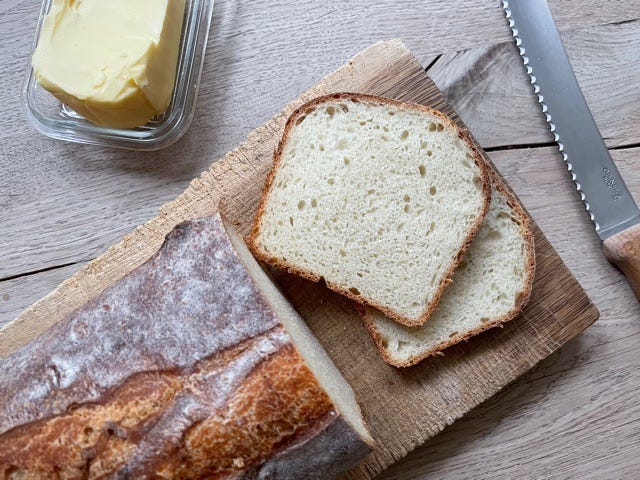There’s probably a bit of a misconception that sourdough bakers look down on yeasted breads, but for the most part I’d say this isn’t true. In my mind, good bread is good bread. A well-made yeasted bloomer has just as much of a place at the table as a naturally leavened loaf made from freshly ground ancient grains.
As with a lot of good things in life, the magic ingredients are giving a sh*t and time, and this recipe for a classic white tin loaf is no exception. It is the very essence of a simple pleasure in that it’s easy to make and tastes great but requires a bit of love and a quite a bit of time.
Sloooowww fermentation is the key here. The recipe uses just a pinch of yeast in the dough that is then fermented for around 12 hours at room temperature, building a lovely sweet, malty flavour. The addition of butter delivers a softer crumb and a bit of richness, whilst also improving the loaf’s shelf life.
Let’s get into it.
Ingredients
575g strong white bread flour
365g cold tap water
45g soft, unsalted butter
12g salt
Pinch of dried yeast
Method
Put all the ingredients into a stand mixer fitted with a dough hook and mix on slow speed for three minutes until everything is incorporated. Leave for five minutes, and then mix the dough on medium speed for 5-6 minutes until you have a smooth, elastic dough.
If you don’t have a mixer, you can do this by hand. Mix the ingredients in a bowl until incorporated, leave as above and then knead for around 10 minutes or until the dough has reached the right consistency.
Now cover your bowl with cling film and leave for 12 hours (overnight). During this time the dough will slowly ferment and develop.
By the morning, or 12 hours later, the dough should have at least doubled in size. Gently scrape it out of your bowl onto a floured work surface, and then pre-shape into a tight boule in the same way as with our basic sourdough.
Cover the dough and then let it rest for 20 – 30 minutes until it has loosened up a bit. For the final shape, simply scrape the dough off your work top and invert it, before rolling it up into a tight cylinder. Place it into a lightly buttered loaf tin that will take a kilo of dough.
Cover the tin and proof the loaf somewhere warm until it has doubled in size. This will take around an hour.
When things are looking good, set your oven to 220c and get it good and hot. You can bake this loaf in a cast iron pot in the same way that we bake our sourdough, if you’re using this method make sure it’s been in the oven for 45 minutes or so before you bake. You can also bake this loaf in a more traditional way in the centre of the oven with a baking tray of water at the bottom to create some steam.
When you’re ready to bake, use a sharp serrated knife or razor blade to slash the top of your loaf, and then get it in to the oven as soon as possible. The loaf will bake for 40 minutes (20 minutes lid on / 20 minutes lid off if you’re baking in cast iron). Give it a turn half-way through the bake to ensure an even bake. Take the bread out of the tin as soon as it’s out of the oven, and cool on a wire rack.
It’s a mightly little loaf with lots of uses, but for my money it’s the ideal sandwich bread. Bacon, toasted cheese, ham and butter, roast beef and horseradish. Maybe even all at once! The (bready) world is your (sandwich) oyster, or something.
F x
Like this? Please share it.
And please check out Brick House At Home on Patreon for our all our tutorials including Basic Sourdough, How To Start & Maintain A Mother, Chilli Cheddar Cornbread Muffins, ANZAC biscuits, American Apple Pie and new tutorials every month!




